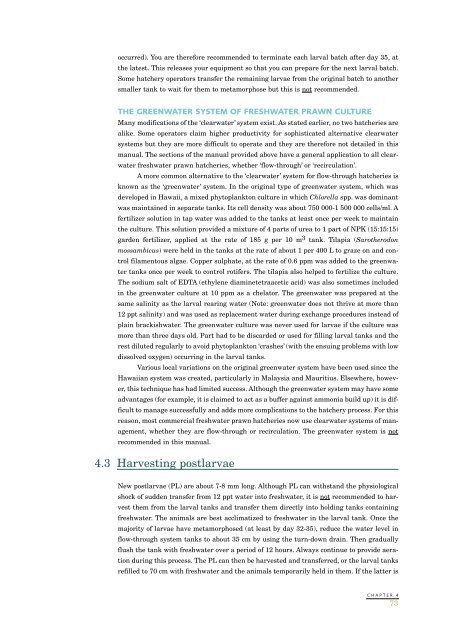You also want an ePaper? Increase the reach of your titles
YUMPU automatically turns print PDFs into web optimized ePapers that Google loves.
occurred). You are therefore recommended to terminate each larval batch after day 35, atthe latest. This releases your equipment so that you can prepare for the next larval batch.Some hatchery operators transfer the remaining larvae from the original batch to anothersmaller tank to wait for them to metamorphose but this is not recommended.THE GREENWATER SYSTEM OF FRESHWATER PRAWN CULTUREMany modifications of the ‘clearwater’ system exist. As stated earlier, no two hatcheries arealike. Some operators claim higher productivity for sophisticated alternative clearwatersystems but they are more difficult to operate and they are therefore not detailed in thismanual. The sections of the manual provided above have a general application to all clearwater<strong>freshwater</strong> prawn hatcheries, whether ‘flow-through’ or ‘recirculation’.A more common alternative to the ‘clearwater’ system for flow-through hatcheries isknown as the ‘greenwater’ system. In the original type of greenwater system, which wasdeveloped in Hawaii, a mixed phytoplankton culture in which Chlorella spp. was dominantwas maintained in separate tanks. Its cell density was about 750 000-1 500 000 cells/ml. Afertilizer solution in tap water was added to the tanks at least once per week to maintainthe culture. This solution provided a mixture of 4 parts of urea to 1 part of NPK (15:15:15)garden fertilizer, applied at the rate of 185 g per 10 m 3 tank. Tilapia (Sarotherodonmossambicus) were held in the tanks at the rate of about 1 per 400 L to graze on and controlfilamentous algae. Copper sulphate, at the rate of 0.6 ppm was added to the greenwatertanks once per week to control rotifers. The tilapia also helped to fertilize the culture.The sodium salt of EDTA (ethylene diaminetetraacetic acid) was also sometimes includedin the greenwater culture at 10 ppm as a chelator. The greenwater was prepared at thesame salinity as the larval rearing water (Note: greenwater does not thrive at more than12 ppt salinity) and was used as replacement water during exchange procedures instead ofplain brackishwater. The greenwater culture was never used for larvae if the culture wasmore than three days old. Part had to be discarded or used for filling larval tanks and therest diluted regularly to avoid phytoplankton ‘crashes’ (with the ensuing problems with lowdissolved oxygen) occurring in the larval tanks.Various local variations on the original greenwater system have been used since theHawaiian system was created, particularly in Malaysia and Mauritius. Elsewhere, however,this technique has had limited success. Although the greenwater system may have someadvantages (for example, it is claimed to act as a buffer against ammonia build up) it is difficultto manage successfully and adds more complications to the hatchery process. For thisreason, most commercial <strong>freshwater</strong> prawn hatcheries now use clearwater systems of management,whether they are flow-through or recirculation. The greenwater system is notrecommended in this manual.4.3 Harvesting postlarvaeNew postlarvae (PL) are about 7-8 mm long. Although PL can withstand the physiologicalshock of sudden transfer from 12 ppt water into <strong>freshwater</strong>, it is not recommended to harvestthem from the larval tanks and transfer them directly into holding tanks containing<strong>freshwater</strong>. The animals are best acclimatized to <strong>freshwater</strong> in the larval tank. Once themajority of larvae have metamorphosed (at least by day 32-35), reduce the water level inflow-through system tanks to about 35 cm by using the turn-down drain. Then graduallyflush the tank with <strong>freshwater</strong> over a period of 12 hours. Always continue to provide aerationduring this process. The PL can then be harvested and transferred, or the larval tanksrefilled to 70 cm with <strong>freshwater</strong> and the animals temporarily held in them. If the latter isCHAPTER 473
















